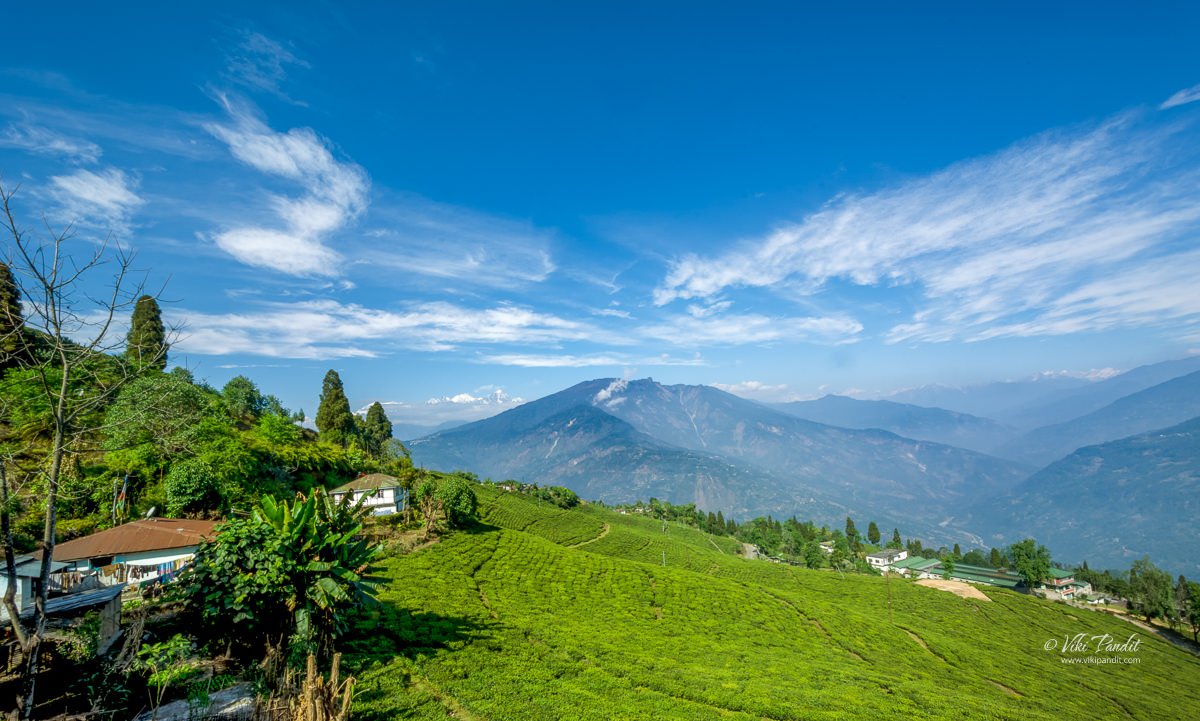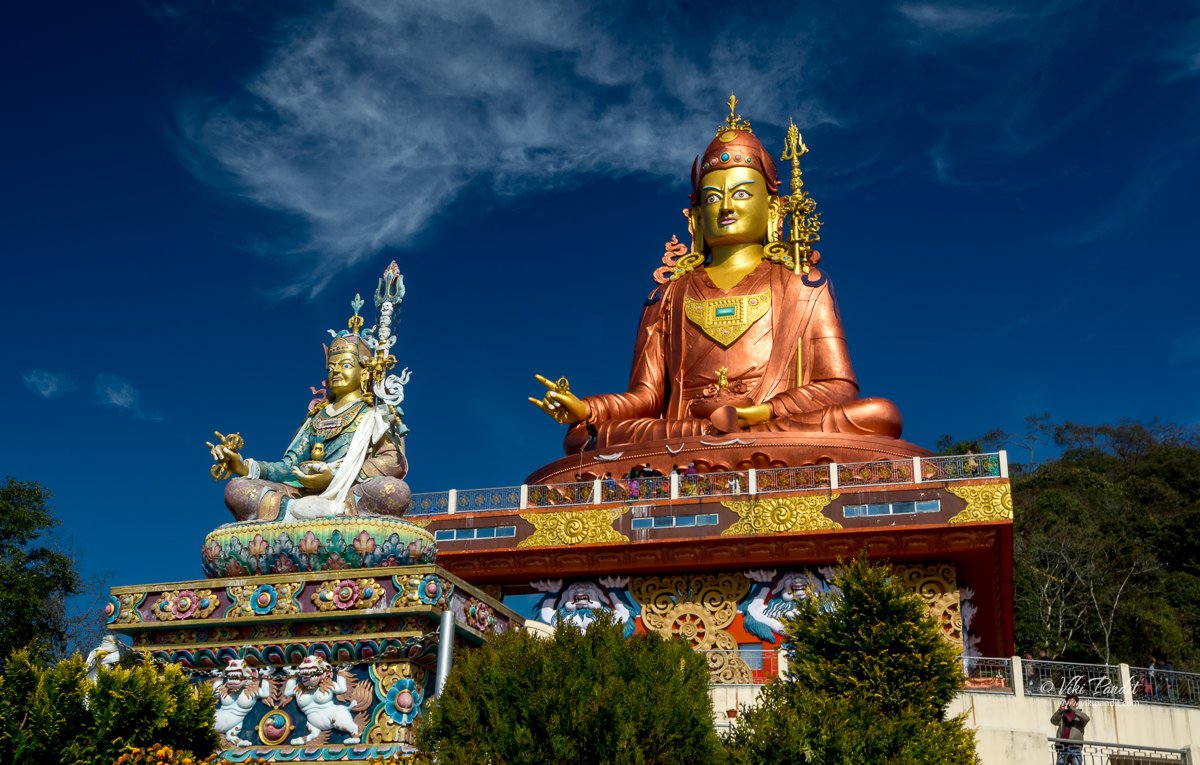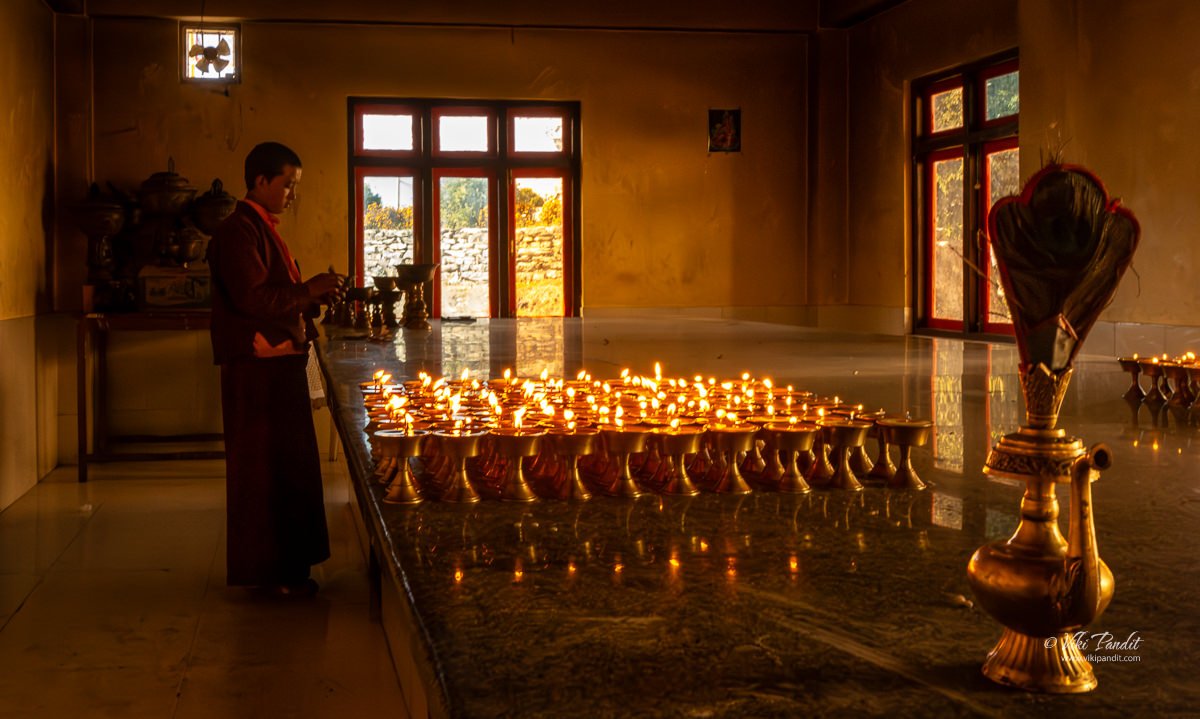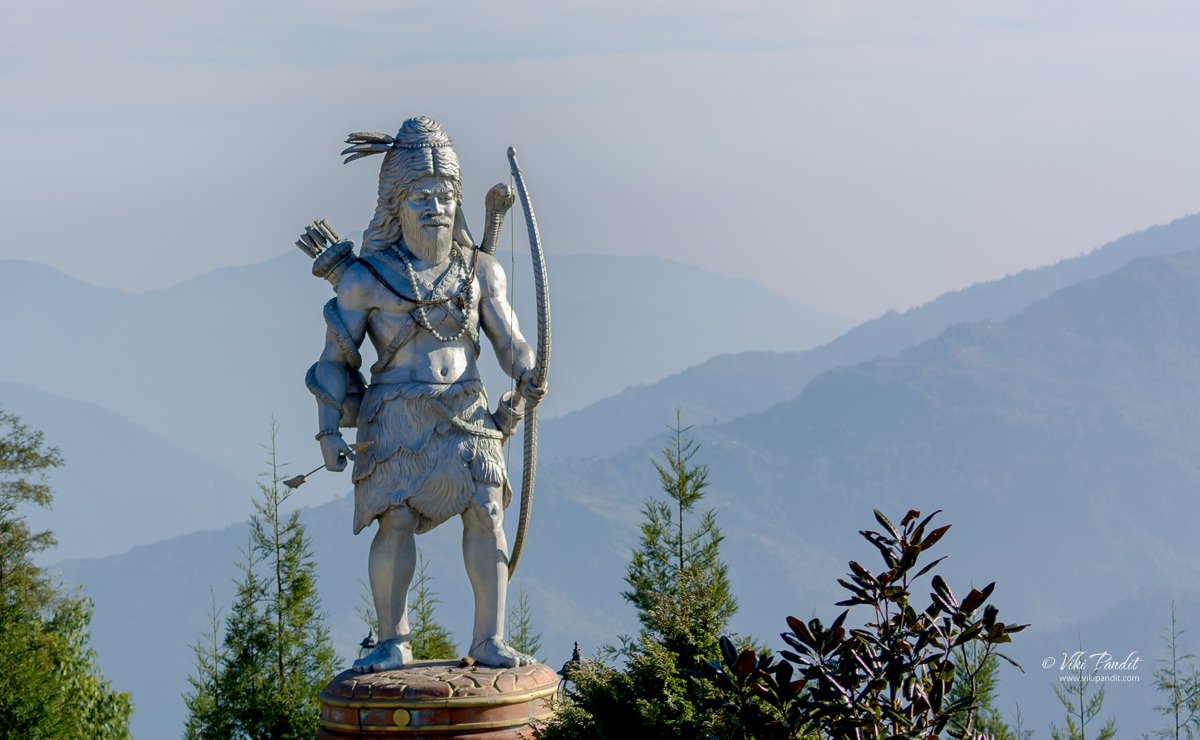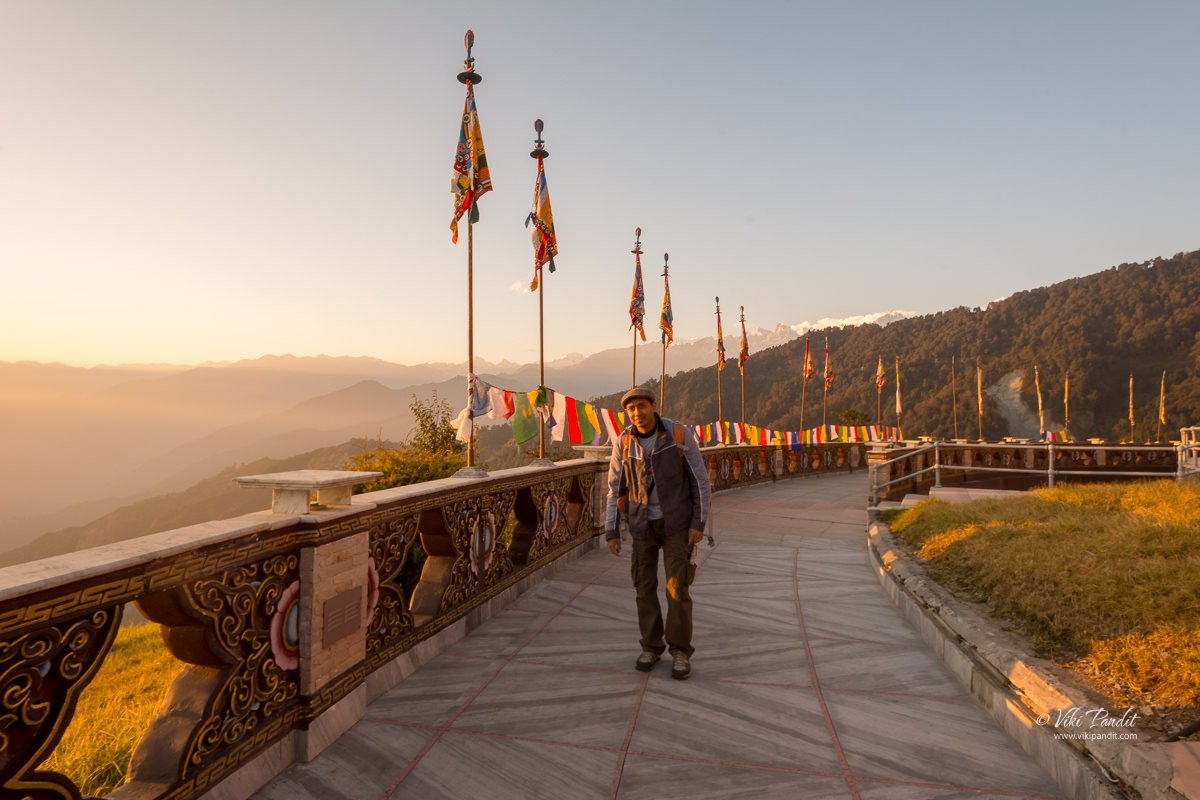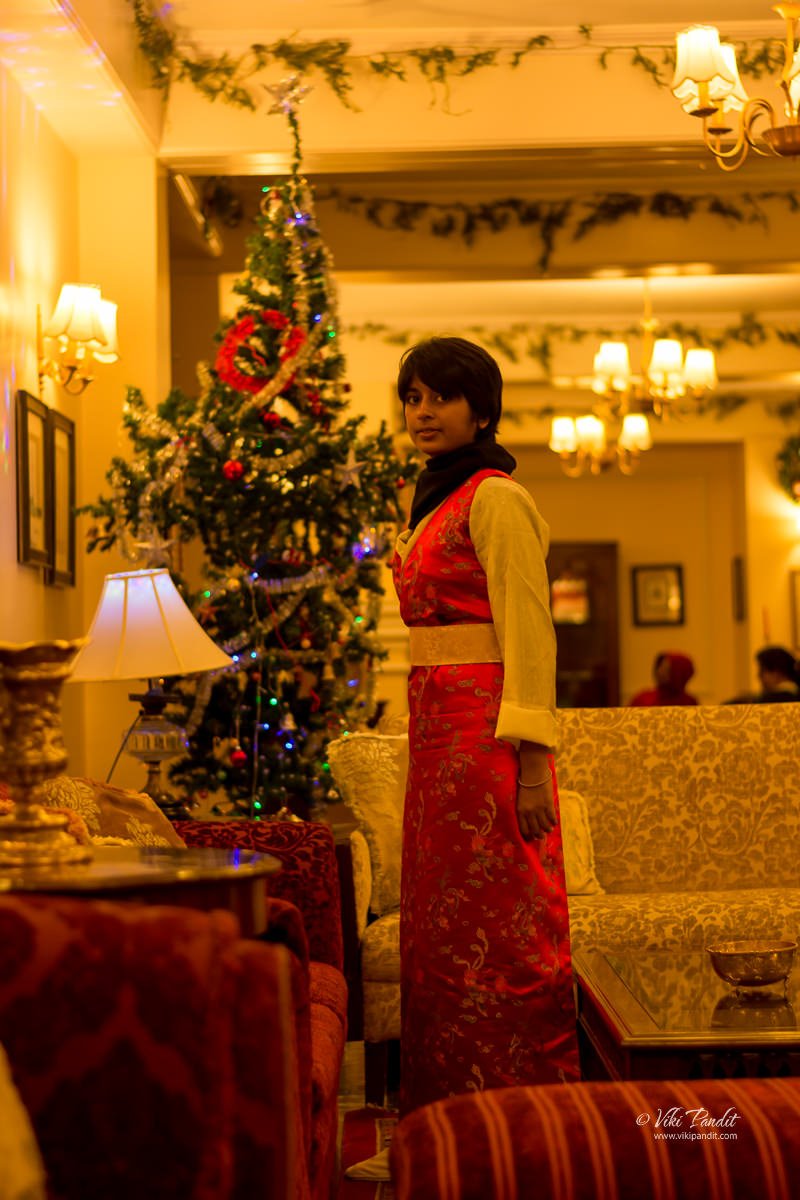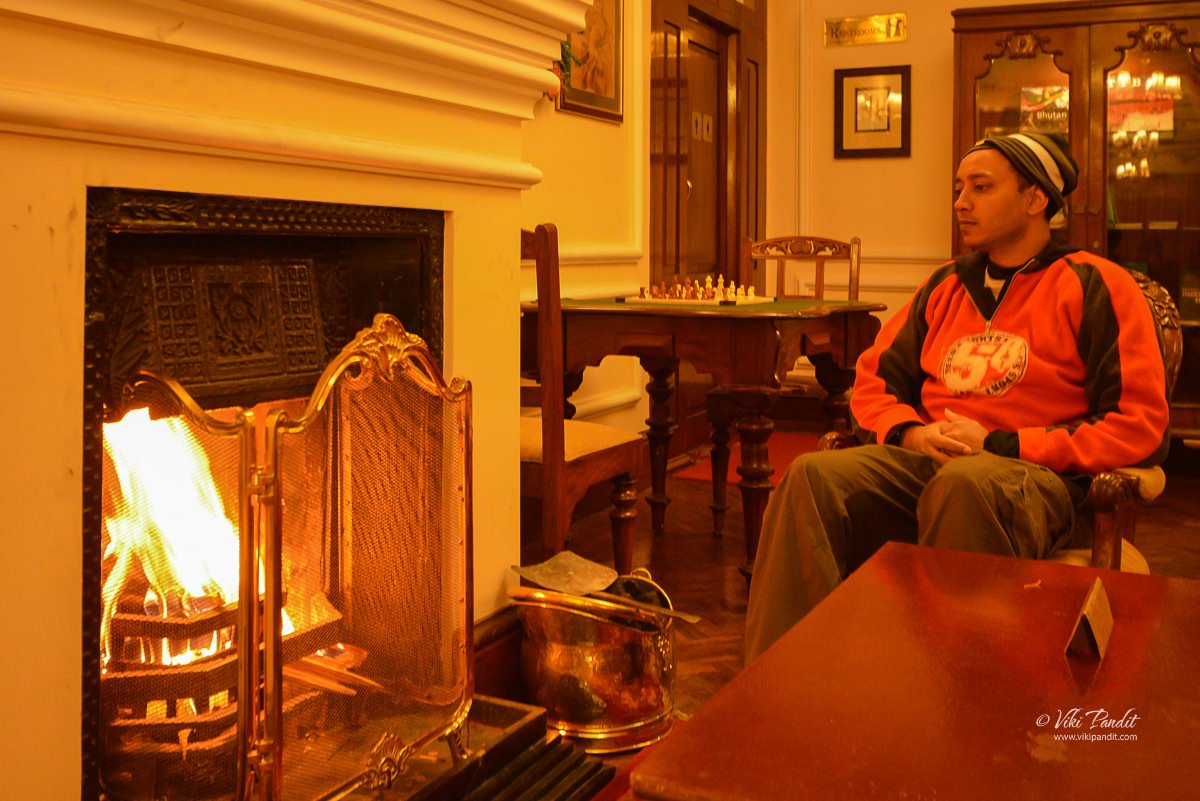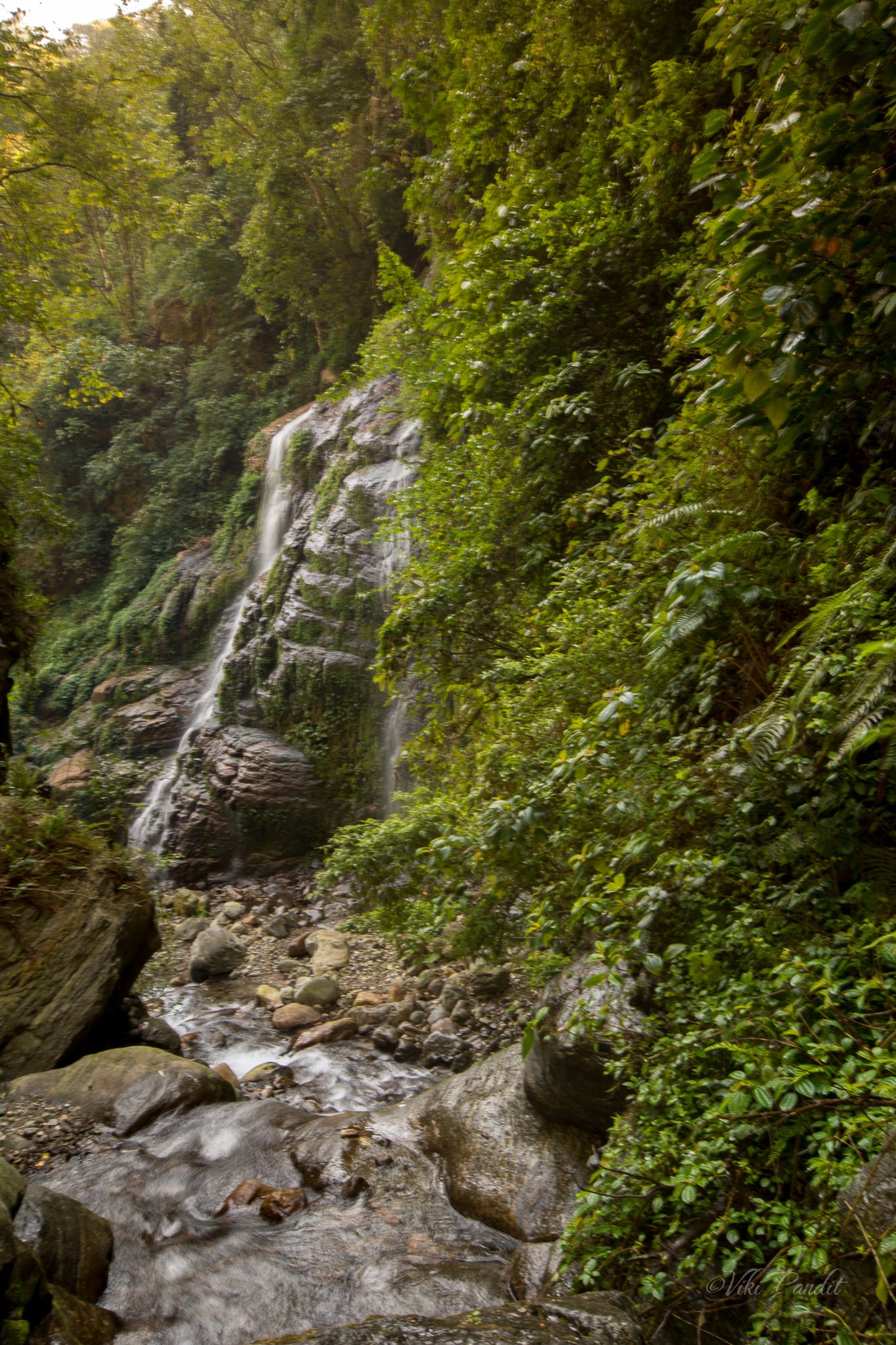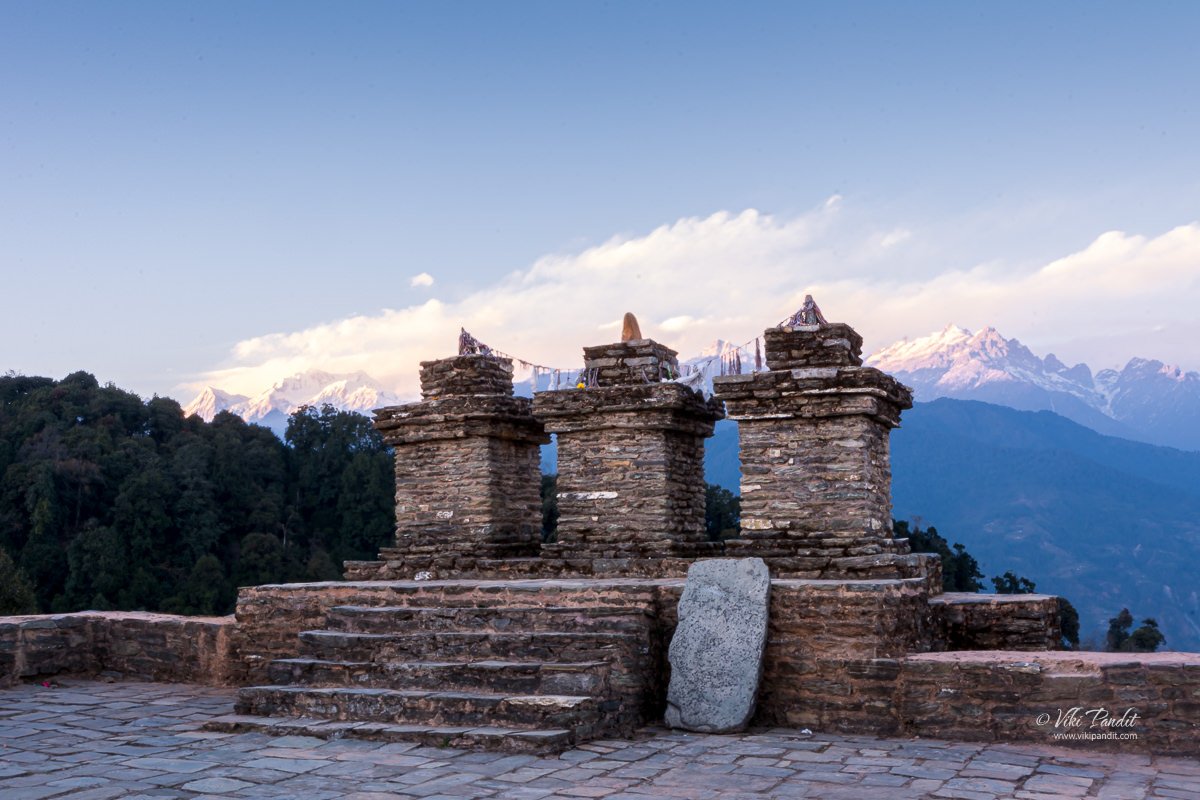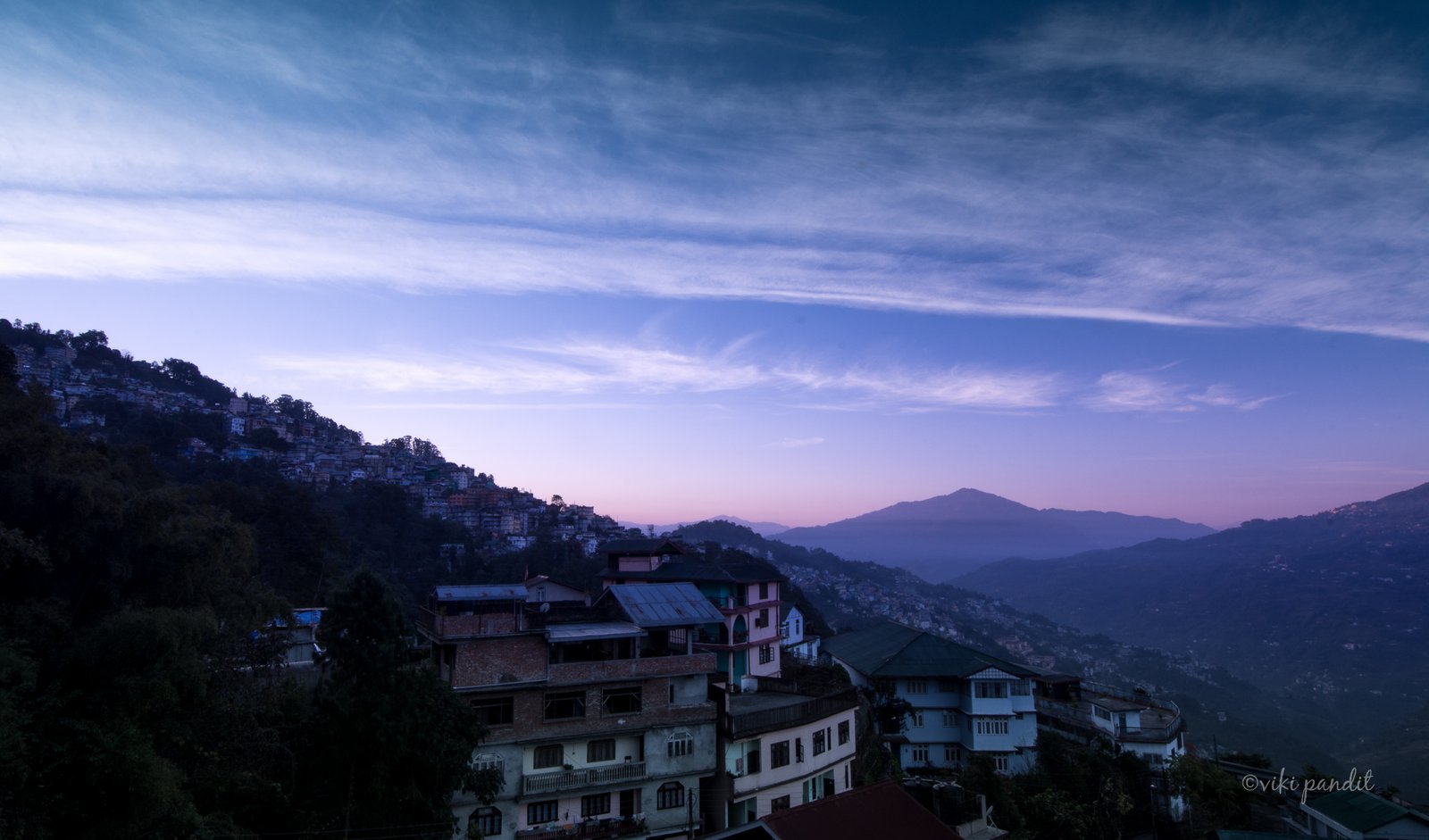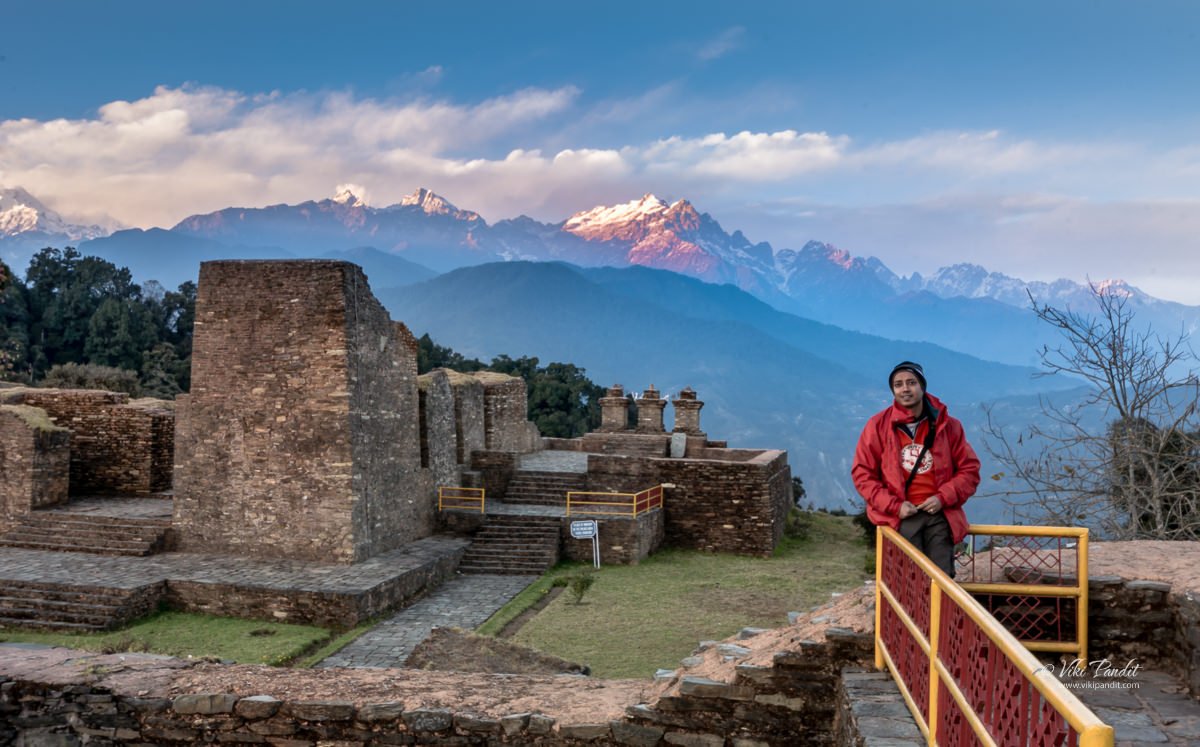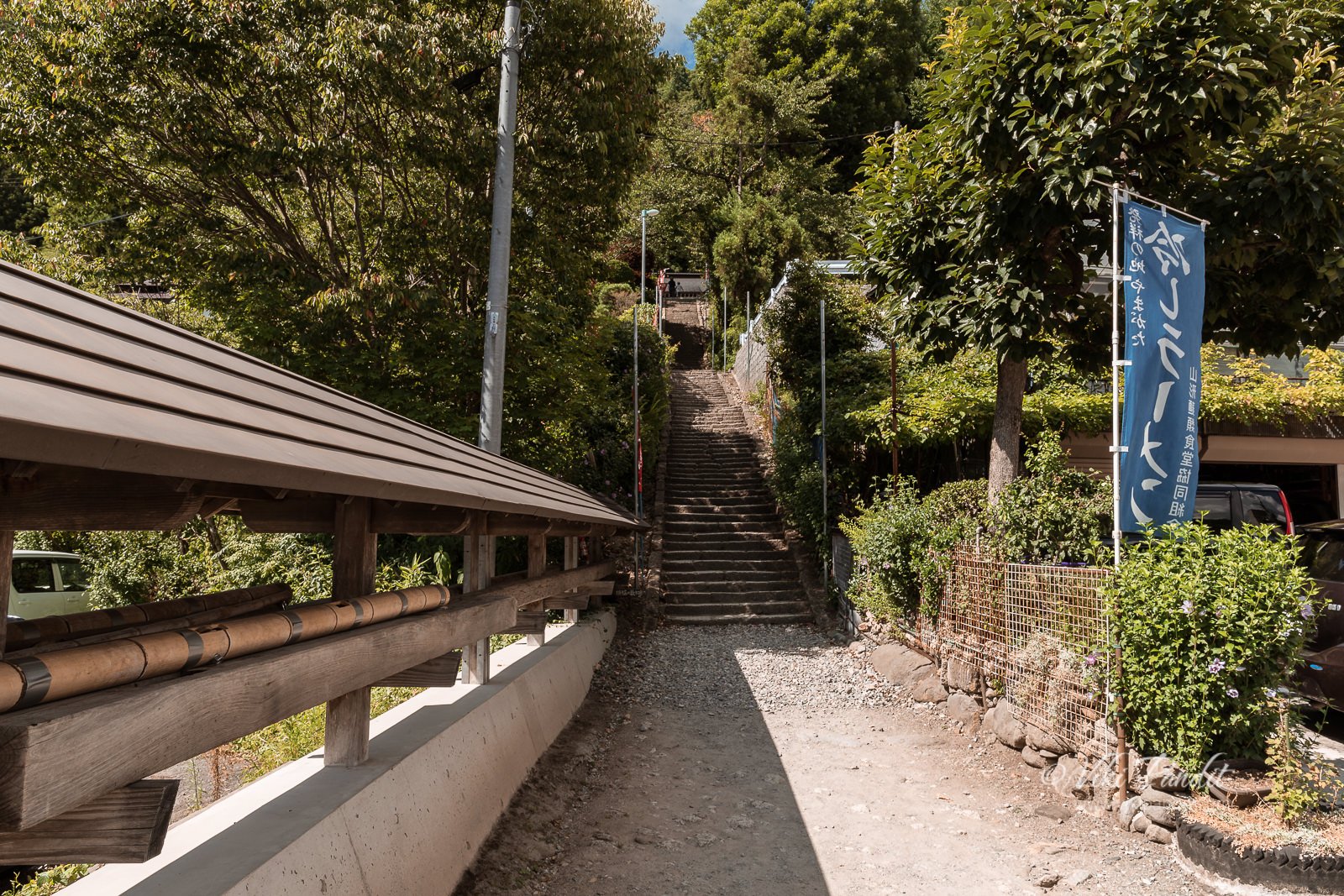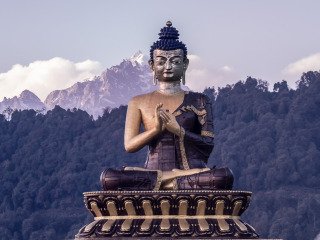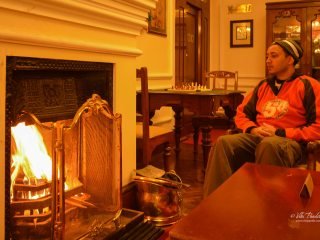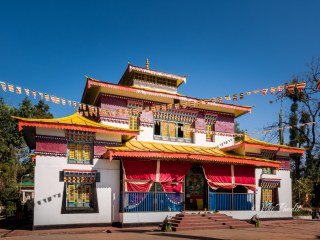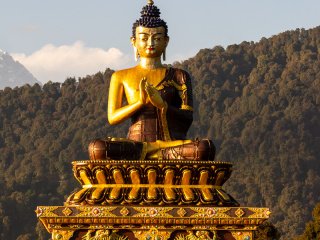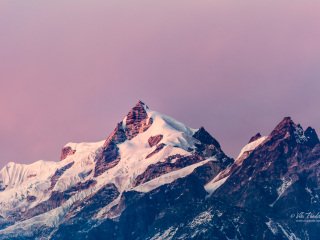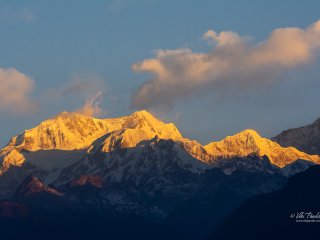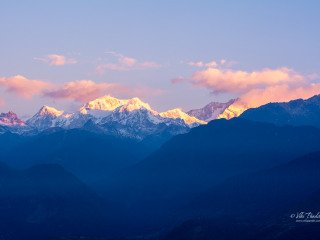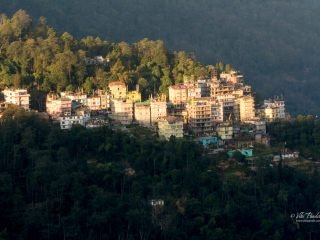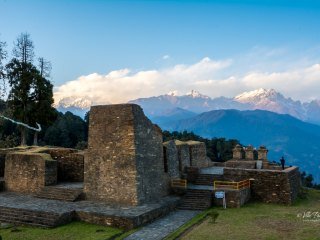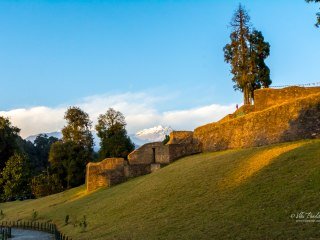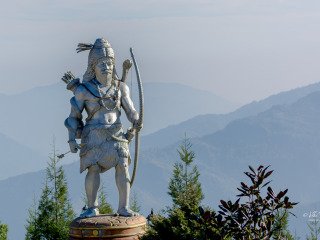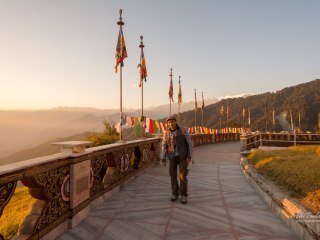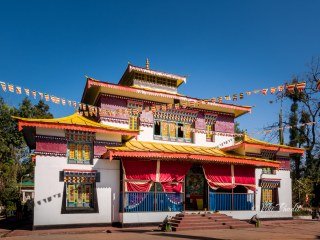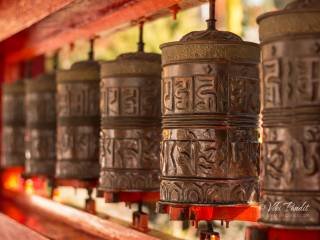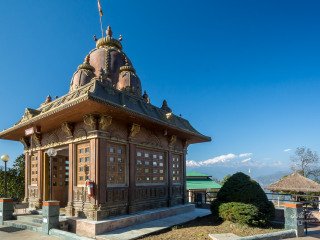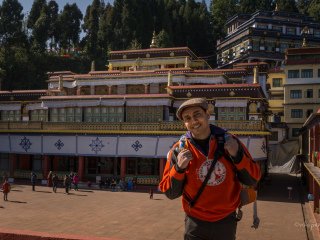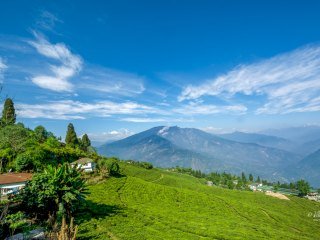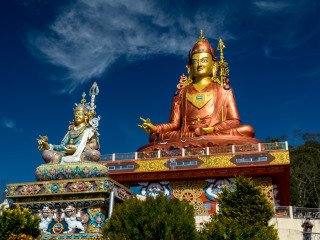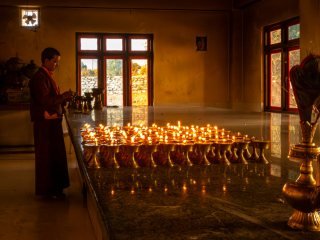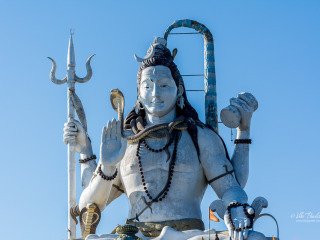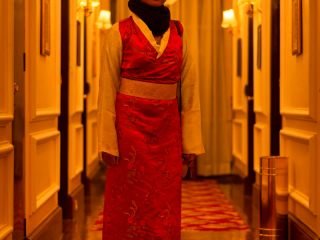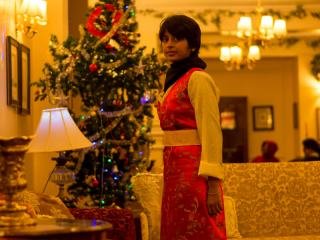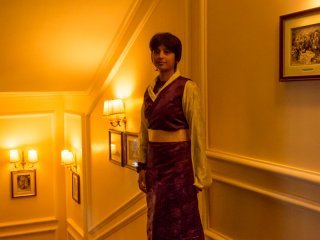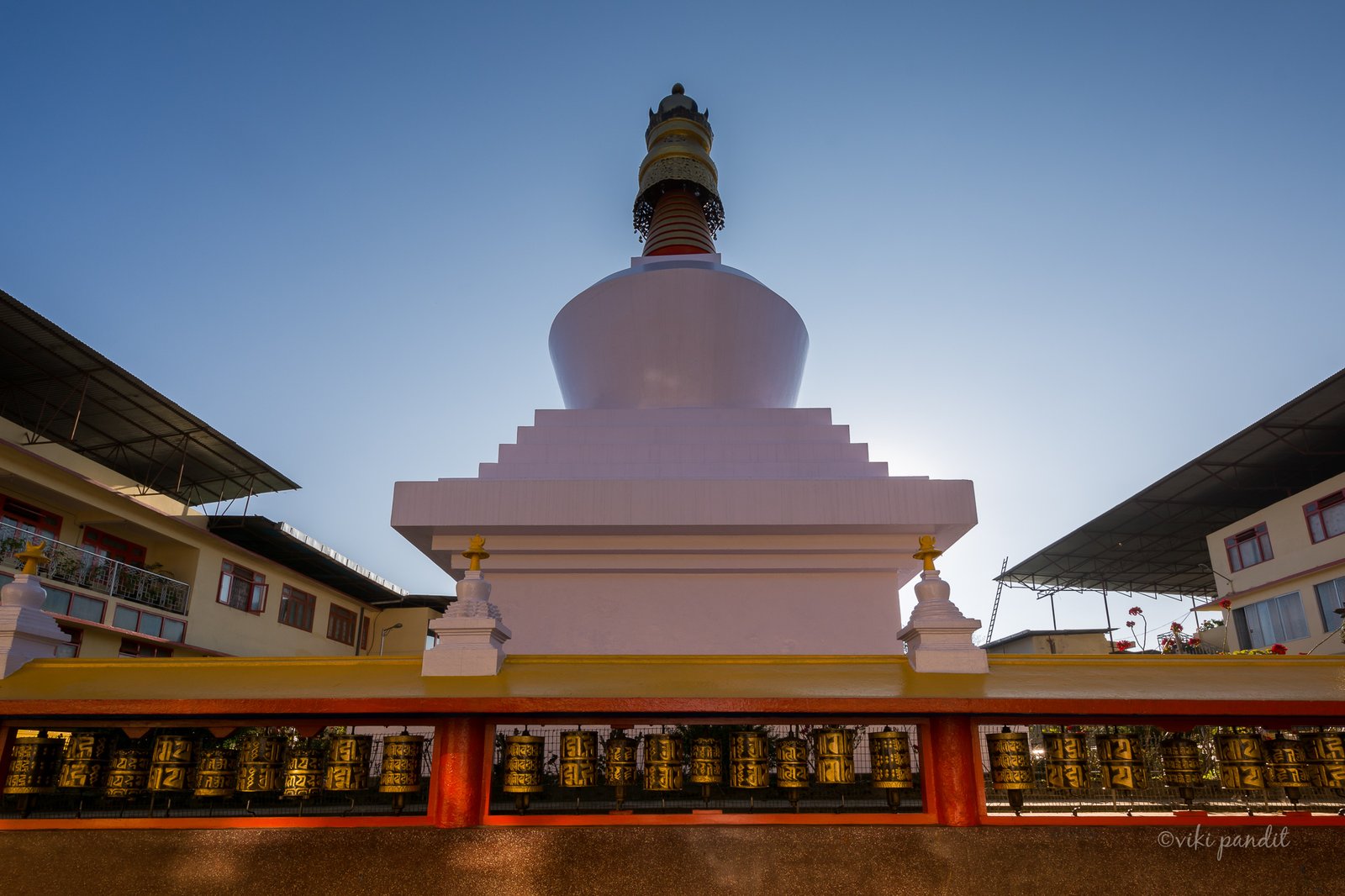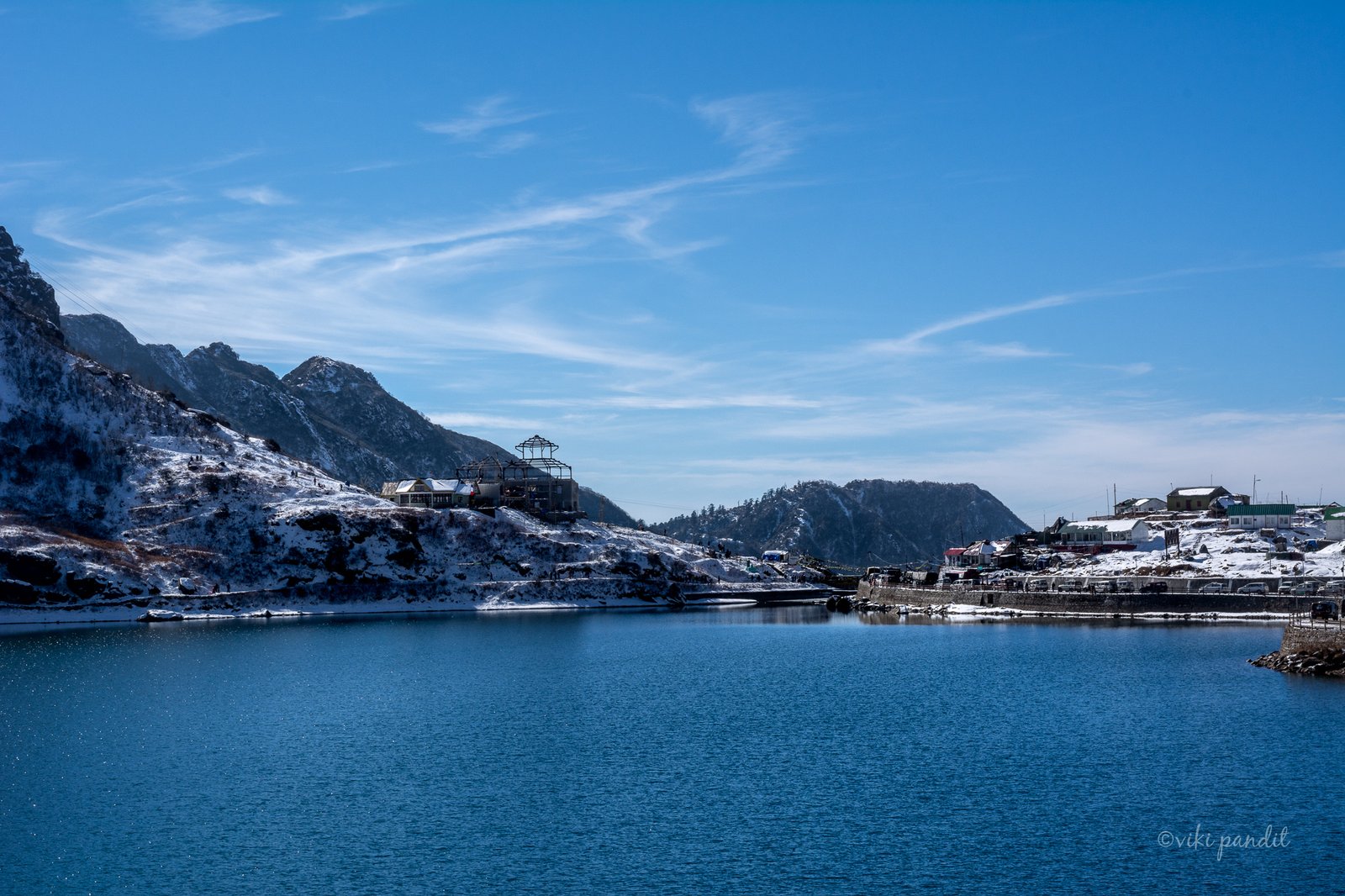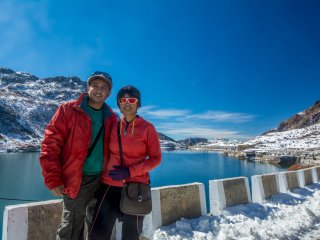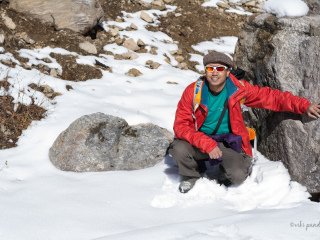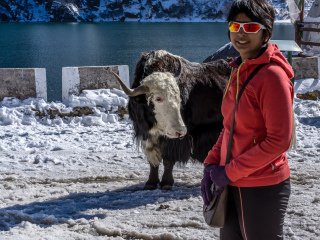Travel creates memories that last a lifetime. As we left the outskirts of Gangtok, we were both still immersed in thoughts of the lovely time we spent at Changu Lake. On our drive to Pelling, we planned to take a longer route going through Namchi, which is renowned for its beautiful tea gardens. Our driver, Vishnu, a very charming Nepali chap, made our trip to Pelling even more entertaining. All through the next three days, he kept us entertained with his jolly stories. I am going to leave his phone # below in the faqs, so anyone interested can contact him.
Temi Tea Gardens, Ravangla
We reached Temi Tea Gardens at around 11 a.m. The drive to Temi took us through lush green mountain slopes lined with ferns. The beautifully landscaped and manicured tea garden is a visual treat. The fascinating beauty of the tea plantation along-with with 180-degree views of Mt. Kangchenjunga thrilled us to no end. A plaque mentioned that the tea garden is run by the Government of Sikkim and they have done a fascinating job.
The tea from these gardens carries a premium the world over for its exotic flavor. We each had a cup of tea at the only shop around. Mani bought a couple of flavors including one Oolong flavor. Vishnu volunteered to take a few pictures of the picturesque gardens behind us.
In February, the Namchi Garden hosts an annual flower show. The prime attraction of this show is the display of exotic and rare orchids. After a lovely cup of tea, we drove on to our next destination: Samdruptse.
Padmasambhava, Samdruptse
From Temi, we headed towards Samdruptse hill in Namchi. We drove about an hour along winding roads to reach the Samdruptse hill. In the local Bhutia language, Samdruptse translates into “wish-fulfilling hill.” We got down at the gate and started walking towards the top. A few minutes into the path, we could see the gigantic statue of Guru Padmasambhava in a meditation pose. At 120 ft tall, it is said to be the highest statue of Guru Padmasambhava in the world. The statue has a fleet of stairs from where one can climb upward to a platform near the statue’s lap. There is a brick Chorten on the side. In front of the giant statue is another smaller statue of Padmasambhava in a different avatar. We stayed there for some time looking at the masterpiece against the beautiful blue sky.
There is a small room towards the right. Inside some devotees were lighting butter lamps. A lamp offering carries the wish to attain Buddha-hood and the aspiration to recognize the clear light at the time of death. We joined them in lighting the lamps. We later came to know that for each lamp you light, one has to pay Rs. 10.00. as donation. By that time we had already lit 35 lamps 🙂
We would have loved to spend some more time here but we moved on as we still had a lot of distance to cover for Pelling.
Solophok Chardham Temple Complex, Namchi
Char Dham complex is situated about 5 km from the town of Namchi on Solophok Hill. However one should not assume the time to travel based on the distance in the hills. It took us over an hour to reach the Char Dham complex. From here if one looks hard, one can see the Guru Padmasambhava on Samdruptse hill in the distance. The principal deity at the Char Dham complex is Lord Shiva. It is believed that during the battle of Kurukshetra, Arjuna came here to worship Lord Shiva.
It is also believed that Shiva, pleased with Arjuna, appeared before him in the guise of a hunter and blessed him. The complex contains the 12 Jyotirlingas, four miniature replicas of the Char Dhams and a huge Nandi bull. The sprawling complex also has arrangements for staying over at the Yatri Niwas Guest House. Bags are not allowed inside and I had a hard time convincing the security at the gate that the backpack I was lugging around was just a camera bag.
The complex has high security and one has to leave the bags outside. I had a hard time convincing security that the backpack I was carrying was a camera bag. Eventually, he did allow me in. We walked around the huge complex for some time. The whole complex was so clean, it felt I wasn’t in India anymore. Near the exit, one can find numerous shops selling souvenirs. As we headed back towards the car, we bought some key chains from one of them.
Buddha Park, Ravangla
Buddha Park is a fairly new addition to the tourist places. It was recommended to us by the guide/driver who took us to Changu Lake and we were not disappointed. The Buddha Park hosts a stunningly beautiful statue of Sakyamuni Buddha. This was the third huge statue we had seen that day. The park area is beautifully landscaped with ample walkways and space for visitors to enjoy the serene surroundings. Set in a picturesque location, the park offers an unmatched view of the Khangchendzonga range just behind the towering Buddha statue and the spiritual ambiance of the location adds to the tranquility.
There is a temple below the statue. Unfortunately, cameras are not allowed inside. As I entered, I felt peace. Right in the center of the room is a life-sized golden idol of Buddha. A flight of circular stairs leads up to the second floor. The walls are covered in paintings depicting moments in Buddha’s life that eventually led him towards attaining true spirituality.
We roamed around the park. Towards the rear of the temple, some sections were still under construction. We didn’t want to leave, but the sun was setting and we still had to cover some 3 hrs drive to Pelling, so off we went reluctantly.
Hotel Elgin, Mt. Pandim
As we neared Pelling, the roads became worse, filled with potholes. Sun sets early in these eastern Hills and by the time we reached Pelling, it was totally dark at around 6 p.m. We went directly to the Hotel Elgin Mount Pandim. It’s on the top of a hill. We were in for a big surprise as we checked in. The Hotel was royalty. The lounge looked like a palatial living room.
A couple of fireplaces kept us warm in the breezy evening. Later I discovered that its previous owners were the royal family of Sikkim and the palace had been converted to a Hotel.
The rooms were luxurious. Beside the bed is a huge window. As I pulled the curtains, we were thrilled to see the magnificent Singalila range bathing in the moonlight. The food at the Hotel was lip-smacking. I can safely rate Hotel Elgin Mount Pandim as one of the more exotic hotels we have stayed in.
Day 2
Pemayangtse Monastery
I woke up early at dawn to watch the Singalila range during sunrise. It was magnificent to watch the orange rays of the sun creeping over the mountains as small pockets of clouds went past. A couple of foreigners were there along with cameras & tripods, catching the memorable view of the mountains. The view of the Kanchenjunga from this Hotel is the best one can get.
The three-hundred-year-old Pemayangtse Monastery is right next to the resort on the hilltop overlooking the Rebdentse ruins. The closeness of the monastery to our hotel was the main reason for staying at Hotel Elgin. One can just walk to the Pemayangtse in 5 minutes while the Rabdanste ruins are at a 10-minute drive.
The second oldest monastery of Sikkim and the headquarters of the Nyingmapa order of Tibetan Buddhism, Pemayangtse Monastery sits atop a ridge high above the Rangit river, surrounded by the brilliant snow-capped Himalayan peaks. The history of the monastery reads that it was founded in the 17th century by Lhatsun Chempo, one of the three lamas of the Yoksum and further expanded by his re-incarnate in the initial years of the 18th century. The monastery draws its name from “padma yang tse” which literally translates into the “sublime perfect lotus.”
A long line of fluttering prayer flags will welcomed us as we went up the hill. The three-storied monastery houses some wonderful paintings and other artwork. It also has a large collection of rare books. Photography is prohibited inside. On the top floor is a huge wooden miniature depiction of monks and monasteries.
Kanchenjunga Waterfall
From the top of Mt. Pandim, we drove down into the pleasant little town of Pelling. On the way to Kanchenjunga waterfall, we passed the Sewaro Rock Garden. I had listed it on our scheduled places to visit in Pelling, but it looked in ruins from lack of maintenance. On the way we also passed a few Orange groves laden with the citrus fruits. Beside one of the groves, few children were selling the freshly plucked fruit on the roadside. They were the tangiest Oranges I have ever tasted.
After an hours drive we finally reached Kanchenjunga waterfall. We had to park the car at a sharp curve some distance away. From there we had to walk up the stairs to reach the waterfall. Some local boys were helping tourists, making their way over some treacherous stones towards the waterfall. The main waterfall is surrounded by the hill on three sides. With so many tourists it was hard to move around. The Waterfall was flowing in full force and we were getting wet just by the thick droplets in the air. My camera lens was getting so foggy and it was impossible to take any pictures.
Kha-Chot-Palri Lake
We drove on towards the Khecheopalri village. Kha–Chot–Palri is estimated to be 3500 years old and means heaven of Guru Padmasambhava. It is believed to be a wish-fulfilling lake. The Lepchas, the main ethnic group of the village refer to is as “Sho Dzo Sho” Lake.
We got down at the main gate. There are some small shops around from where yo can grab some food. From here there is about a fifteen minutes walk through a lovely tropical forest. There is a Chorten along the way. Beside the path, on the rocky walls there are scattered Tibetan inscriptions. As we reached the lake I saw a small shrine where one can offer prayers. According to local folklore, the leaves are not allowed to float on the lake. The birds in the vicinity, pick them up as soon as they drop on the lake surface. There is a jetty that leads to the front of the lake and from where prayers are offered. Prayer wheels are fixed along the jetty. The jetty was very crowded and we just stayed at the edge of the lake. Prayer flags are everywhere. After spending some time here we headed back to the hotel.
Back at the Hotel, they had some very interesting menu lined up for Lunch. I have already forgotten the names of the dishes, but they sounded very French.
Rabdentse Ruins
After taking some rest, we left the Hotel at around 4 p.m. From the hotel, it barely takes 10 minutes to reach the entrance to Rabdentse. The ruins lie hidden from the main road within a dense foliage of Oak trees. Rabdenste was once the seat of the power in Sikkim for more than a hundred years. Today, the ruins of this ex-capital of Sikkim are just a tourist attraction.
We got down at the ornamental yellow gate and walked along a narrow uphill path towards the once flourishing palace that used to be the abode of Sikkim monarchs. It’s a long walk but there are plaques along the path that kept us telling the distance renaming till the ruins. I assume, we walked around a kilometer to reach the palace ruins. Towards the end of the path, the beautiful forest slowly merges into the palace courtyard.
There was a sign that said we needed to buy tickets to enter, but there was no one at the counter, so we moved ahead. A few paces further, we saw the ‘Taphap Chorten‘ in semi ruined condition. Just beside it is a is a stone plaque with information on the history of Rabdentse. This was the entry point to the Palace and in historical times, visitors seeking access to the palace had to dismount from their horses here. The capital city was destroyed by the invading Gurkha army and only the ruins of the palace and the chortens can be seen here now.
The palace ruins are at the center of the courtyard. Next to the ruins of the palace are three Chortens. The members of the royal family used to offer prayers to the deities at these Chortens. Surprisingly, the chortens still are in a fair state of preservation. The Archaeological Survey of India has declared Rabdentse as a heritage monument and has undertaken the needed preservation and restoration measures.
Day 3
Transfer to Bagdogra
We had an early breakfast and started by 9 a.m. for Bagdogra. Our flight was at 5 p.m. and the Vishnu, the driver had informed us that it will take at-least six hours to reach. He also mentioned that due to construction on the road, there could be minor stoppages along the way too. Pelling to Bagdogra is not a popular route, so when I asked him, he told us that the last time he drove on this road was three years back. True to his sources, we had to stop for half an hour along a stretch where the hill was being cut to make the road wider. Big boulders were falling from above, some large enough to smash a car into a pancake. They stopped for a while. The road was cleared of the boulders by a crane and we were off.
It was a 3 hour rocky journey till we joined the NH31A highway. The Teesta with its flowing green water kept me wide-eyed all the way. There were numerous times I wanted to stop and admire the bends and curves but we didn’t have the luxury of time. Once we crossed into West Bengal, the roads were a lot better. We saw some monkeys on the sides of the road. The tourists probably feed them and they were dangerously walking on the road where generally cars were traveling at 60-80 km/hr.
On the way we stopped for a break at the City Center Mall near the airport. It’s a huge mall almost similar in design to the City Center 2 in Kolkata. We grabbed some food there and then headed to the airport. On arrival to the airport as we were checking in, we were informed that the flight was delayed by 40 mins. We used that time to check out the airport shops. By 6 p.m., with some pleasant memories, we were on our way back to Kolkata.
Pelling is pleasant during December. In mid-December one can see the snow-covered Kanchenjunga mountains. It’s a sight to behold
If you are visiting Pelling, you must also visit Namchi & Ravangla. The Buddha Park in Ravangla is a lovely place with a huge Buddha Statue.
Kanchenjunga WaterFall
Khecheopalri Lake
Orange Gardens
Vishnu was with us for the three days we were in Pelling.
His contact number is +91 9734 181 355
Disclaimer: I loved our travel with him, but I do not accept any responsibility for his actions if you use his services.

